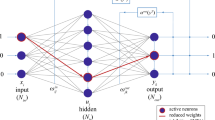Abstract
This paper further studies the ability of the associate learning and self-correcting in a memristive artificial neural network (ANN). Different from the existing models, the present ANN contains the multiply-threshold neurons, the discrete charge-controlled memristors, and a new learning law named the max-input-feedback (MIF). We shall demonstrate the processes of the associative learning and associative correcting via a modified Pavlov experiment where more conditioning factors are considered. We also make some comparisons of MIF with spike-timing-dependent plasticity and back-propagation and show that MIF learning law is suitable to fast learning.








Similar content being viewed by others
References
Chua LO (1971) Memristor: the missing circuit element. IEEE Trans Circuit Theory 18(5):507–519
Strukov DB, Snider GS, Stewart DR, Williams RS (2008) The missing memristor found. Nature 452(7191):80–83
Chua LO, Kang SM (1976) Memristive devices and systems. Proc IEEE 64(2):209–223
Ventra MD, Pershin VY, Chua LO (2009) Circuit elements with memory: memristor, memcapacitors and meminductors. Proc IEEE 97(10):1717–1724
Kim H, Sah MP, Yang C, Chua L (2010) “Memristor-based Multilevel Memory”, CNNA 2010 12th international workshop. Berkeley, CA, pp 1–6
Snider G (2007) Self-organized computation with unreliable memristive nanodevices. Nanotechnology 18(36):1–13
Sangho S, Kyungmin K, Sung-Mo K (2011) Memristor applications for programmable analog ICs. IEEE Trans Nanotechnol 10(2):266–274
Jo SH, Chang T, Ebong I, Bhadviya BB, Mazumder P, Lu W (2010) Nanoscale memristor device as synapse in neuromorphic systems. Nano Lett 10(4):1297–1301
Pershin YV, Ventra MD (2011) Neuromorphic, digital and quantum computation with memory circuit elements. arXiv:1009.6025v2, pp 1–9
Pershin YV, Ventra MD (2010) Experimental demonstration of associative memory with memristive neural networks. Neural Networks 23(7):881–886
Itoh M, Chua LO (2009) Memristor cellular automata and memristor discrete-time cellular neural networks. Int J Bifurcation Chaos 19(11):3605–3656
Biolek Z, Biolek D, Biolkova V (2009) SPICE model of memristor with nonlinear dopant drift. Radio Eng 18(2):210–214
Batas D, Fiedler H (2011) A Memristor SPICE implementation and a new approach for magnetic flux-controlled memristor modeling. IEEE Trans Nanotechnol 10(2):250–255
Shin S, Kim K, Kang S-M (2010) Compact models for memristors based on charge-flux constitutive relationships. IEEE Trans CAD Int Circ Syst 29(4):590–598
Strukov DB, Borghetti JL, Williams RS (2009) Coupled ionic and electronic transport model of thin-film semiconductor memristive behavior. Small 5(9):1058–1063
Ramos CZ, Mesa LAC, Carrasco JAP, Masquelier T, Gotarredona TS, Barranco BL (2011) On spike-timing-dependent-plasticity, memristive devices, and building a self-learning visual cortex. Frontiers Neurosci 5:22
Yen G, Michel AN (1992) A learning and forgetting algorithm in associative memories: the eigenstructure method. IEEE Trans Circuits Syst 39(4):212–225
Masquelier T, Thorpe SJ (2007) Unsupervised learning of visual features through spike timing dependent plasticity. PLoS Comput Biol 3(2, e31):247–257
Rumelhart DE, Hinton GE, Willians RJ (1986) Learning representations by back-propagating error. Nature 323(9):533–536
Sinder GS (2008) Spike-timing-dependent learning in memristive nanodevices. IEEE international symposium on nanoscale architectures, Nanoarch, pp 85–92
Masquelier T, Guyonneau R, Thorpe SJ (2009) Competitive STDP-based spike pattern learning. Neural Comput 21(5):1259–1276
Pdeger H (1990) Properties of neural networks with multi-State Neurons. Springer, New York, pp 33–47
Si J, Michael AN (1995) Analysis and synthesis of a class of discrete-time neural networks with multilevel threshold neurons. IEEE Trans Neural Netw 6(1):105–116
Chang T, Jo SH, Lu W (2011) Short-term memory to long-term memory transition in a nanoscale memristor. ACS Nano 5(9):7669–7676
Acknowledgments
This work was supported by the National Natural Science Foundation of China under Grant 60974020, 60972155, 61101223, the Fundamental Research Funds for the Central Universities of China under Grant CDJXS10182215, CDJZR10185501, the Natural Science Foundation of Chongqing under Grant CSTC2009BB2305, and the Fundamental Research Funds for the Central Universities under Grant XDJK2010C023.
Author information
Authors and Affiliations
Corresponding author
Rights and permissions
About this article
Cite this article
Chen, L., Li, C., Wang, X. et al. Associate learning and correcting in a memristive neural network. Neural Comput & Applic 22, 1071–1076 (2013). https://doi.org/10.1007/s00521-012-0868-7
Received:
Accepted:
Published:
Issue Date:
DOI: https://doi.org/10.1007/s00521-012-0868-7




